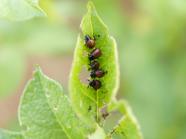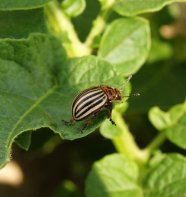Strategy against Colorado potato beetles

Larvae feeding on leaf
Relevant damage is caused by the Colorado potato beetle especially with dry and warm weather in spring and summer. Under these weather conditions two, sometimes even three generations can develop. In our climatic conditions, in general, there is only one generation. That is why the weather conditions over the next few months will decide if feeding larvae will cause yield losses.
Damage caused by Colorado potato beetle
From egg to larva
Colorado potato beetles emerge in spring at the same time as potato plants (from a soil temperature of 15 degrees on), in potato fields of the previous year. After maturation feeding of about 10 to 14 days females lay some 400 orange coloured eggs in batches of ca. 20 on the underside of leaves. Emergence of larvae occurs 10 to 14 days after oviposition depending on weather conditions, with very cold weather even later. After emerging larvae feed on their eggshells before they start feeding on leaves. The first two instars (L1 and L2) do not cause any considerable damage on plants. The last two instars (L3 and L4) cause the actual damage which can lead to sceletonizing with only stems of the potato plant left over.
From larva to beetle
 Zoombild vorhanden
Zoombild vorhanden
Colorado potato beetle on leaf
Insecticides against Colorado potato beetle
For years insecticides from the group of the pyrethroide class were standard for controlling the pest. Since about 10 years Colorado potato beetle larvae are resistant against these products or at least the products are less effective. Fortunately since a couple of years a number of products containing other active ingredients are available to control the larvae. Of these insecticides, e.g. Danjiri and Mospilan SG also have a good effect against aphids.
Long-term success by integrated strategy
Controlling the Colorado potato beetle in the present season is a fist short term objective. In addition also the medium and long term objective of preserving effectiveness of available products and delaying resistance should be kept in mind, as experience has shown in recent years.
That is why the following aspects should be considered:
- Carry out treatment only when damage threshold of 15 young larvae per plant is reached. For this purpose check 25 potato plants for larvae regularly after beetles occur in crop.
- Early treatment: for sufficient effect of insecticides the majority of larvae should be first and second instars. Biological insecticides (NeemAzal T/S) must be applied earlier because of their weaker effect compared to synthetic insecticides. The optimal date for treatment is the first occurrence of first instar larvae.
- If repeated treatments are necessary do not only change the product but also the active ingredient. Do not use pyrethroids at all, because they no longer have a sufficient effect on the Colorado potato beetle.
- Daytime temperatures above 20 degrees and wilted crops: treat only in the early morning, because the pest feeds most at this time of day and takes up a lot of the active ingredient. Consider limited number of treatments permitted.
- Water volume rate and driving speed: use a minimum of 400 l/ha and drive 5 to 6 km/h at the most.
- Do not reduce insecticide application rate and adapt spraying interval to effective period of insecticide (temperature-dependent); a possibly necessary second treatment should be carried out again when most larvae are in first or second instar stage.
Internet warning service
It has already been mentioned how important it is to pick the optimal date for treatments to effectively control the pest. The Colorado potato beetle warning service, on the homepage of the Bavarian State Research Centre for Agriculture, the official Bavarian plant protection service, makes support available for farmers concerning the timing of measures. The forecasting system is based on data on infestations of more than 50 plots, provided by the Departments for Food, Agriculture and Forestry, and on the prognosis system SIMLEP. Based on weather data the model calculates the beetle’s development from the occurrence of eggs to different larval instars. Farmers receive information concerning mass occurrence of eggs and fist instar larvae as well as spraying dates. The web page is interactive, the farmer can enter the date he found eggs in his crop the first time then the model calculates the optimal spraying date for his specific field. The prognosis model has a lead time of approx. 1 week so that there is sufficient time to plan the insecticide treatment.







